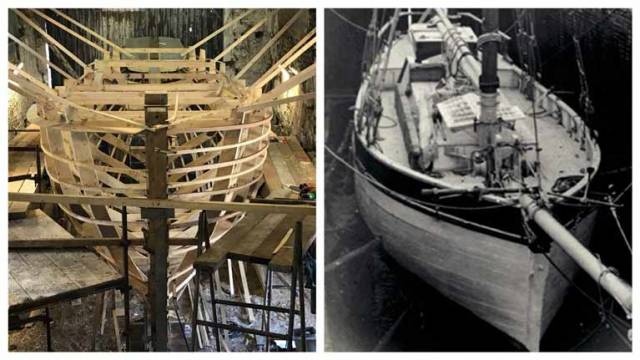While the 56ft 1926-built restored ketch Ilen is a flurry of activity at Oldcourt near Baltimore in West Cork with the final stages of work before her re-launching late next month, in the Top Shed nearby where Conor O’Brien’s pioneering world-girdling Saoirse of 1922 is being re-built, there’s a more measured pace to the work writes W M Nixon
For this isn’t just any boat - Saoirse is something very special. Master shipwrights Liam Hegarty and Fachtna O’Sullivan and their team are putting all their skills into the re-build - working with plans taken off by Uffa Fox in 1927 - in order to provide commissioning owner Fred Kinmonth with a vessel which properly reflects the high regard in which Conor O’Brien’s circumnavigation of 1923-25 is held.
The photos show how the technology of 1922, and the skills of original boatbuilder Tom Moynihan, are being brought alive again in a setting which has for so long been associated with the restoration of Ilen. But once that larger ship had been taken out at the beginning of January to clear the way for Saoirse to be re-born, a new atmosphere began to prevail between the old stone walls, and the re-emergence of Saoirse, even if she is still at a very preliminary stage, is a wonder to behold.
 Only the backbone is going to be part of the finished vessel, but the shape of Saoirse can be clearly discerned from the forms and battens now in place. Photo: Gary Mac Mahon
Only the backbone is going to be part of the finished vessel, but the shape of Saoirse can be clearly discerned from the forms and battens now in place. Photo: Gary Mac Mahon
More than ever, it brings a keen anticipation of sailing aboard a small vessel which punched way above her weight in setting some remarkable speeds in open water. Quite how she managed it is one of the reasons Uffa Fox was so keen to take off her lines when Conor O’Brien took her over to Cowes to do the Fastnet Race of 1927, the year after he’d sailed Ilen out to the Falklands.
This photo of Conor O’Brien in the first stage of the voyage, sailing the North Atlantic from Dun Laoghaire to Pernambuco in Brazil, tells us something of the secret of her unexpectedly high average speeds. They’re in the northeast trades probably in the region of the Canaries where they did the best day’s run of the entire voyage, clipping along in very fine style as the bow-wave and wake reveals. Yet the new little ship exudes an air of comfort, helped by the relaxed image projected by Conor O’Brien at the helm.
 Saoirse at sea early in July 1923, on a maiden ocean voyage both for the ship and owner-skipper Conor O’Brien. On the helm, he is conspicuously relaxed in the knowledge that his new design performs exactly as intended
Saoirse at sea early in July 1923, on a maiden ocean voyage both for the ship and owner-skipper Conor O’Brien. On the helm, he is conspicuously relaxed in the knowledge that his new design performs exactly as intended
For by this stage, he knew his little ship – which he’d designed himself – was a winner on ocean sailing with sheets freed. We tend to take this knowledge for granted now. But what is forgotten is that when Saoirse departed from Dun Laoghaire with much fanfare on June 20th 1923, neither she nor her owner had ever completed an ocean sailing voyage.
Yet now, here is O’Brien savouring the fruits of his creative labour, and he does it with style. Far from being attired in rugged seafaring gear, he’s dressed as though he’s on his way to an informal and convivial lunch at some friendly country house, followed perhaps by some mildly tipsy tennis. That summery shirt, collar spread wide, together with the tweed jacket, speak of everything except being at sea and sailing quite fast.
However, if we look more closely, we note that his tweed jacket’s left arm - draped nonchalantly along the taffrail - is soaking wet. A playful wave of the sea has decided that he can’t be allowed to get away with this performance without something happening. But with the camera out, O’Brien is determined to play it for all its worth, and the image of a pioneering ocean voyager without a care in the world is beautifully captured.































































